BARRY’S BAY – Recycling rules seem to be ever changing. What can be recyclable one day seems to be trash the next.
Sue McCrae, general manager of the Ottawa Valley Waste Recovery Centre (OVWRC,) was in Barry’s Bay on February 22 to speak with staff and council of the Madawaska Valley Township. Her presentation was called, Let’s Get this Sorted Out.
“We want to make sure the front line people are well versed in what is and what is not acceptable in the program,” McCrae said.
The township is a non-partner municipality with the OVWRC, meaning that the township pays fees to bring recyclable materials to the facility. The centre outside of Pembroke accepts two streams of materials: fibres and containers.
“There has been a lot of confusion amongst our residents about what is a container and what is a fibre,” McCrae admitted.
When materials are shipped to the centre, they are separated into one of the two streams, and taken to a sorting line where someone manually picks through what is acceptable and what is not.
“It is very labour intensive,” she said. “If somebody puts the wrong thing in their container, generally they are pulled off by hand.”
A magnet helps the process and gathers any small pieces of steel like nails or bolts.
“We want to make sure that we only put in material that is actually recyclable because the more waste that comes across this line the more cost the program incurs to make sure we clean it up,” she said. “We don’t want the wrong materials on the line.”
Hiring people to pick through recyclables and organics comes at a cost, McCrae explained.
“The more unacceptable material that is mixed in, the higher the cost. The higher our cost is, the higher the tipping fees are for the municipalities,” she said.
WHY THE RULES ARE SO STRICT
The OVWRC separates material in various types, such as paper and plastic. The material is then sold to various markets around the world, such as China and Europe.
“We are looking at a global market, and you better make sure that whatever is in those bails better be what we say it is because when it gets to China and it is full of garbage, who pays for it to come back? The recycling facility,” she said. “We have to make sure that what we are doing is producing a clean, marketable product from what would have been waste and landed up in a landfill.”
This also means that if there is no market for a certain material, then it will likely not be accepted at the OVWRC.
When organic waste comes to the facility in the winter time, it is stored in a special area where the floor is equipped with glycol lines to warm the material overnight.
Then, the material goes for sorting. An employee literally rakes through the organic material, searching for anything that does not belong. This includes plastic bags or biodegradable bags.
If a bag were to be mixed in with the material, it would get caught in the augers of a mixer used to break down the organic material for composting. When this happens, it adds to the maintenance cost of the facility.
“If [residents] use these bags, then they are wasting their time and they are incurring costs that will jack up your tipping fees,” McCrea said.
Even though biodegradable bags are marketed as green alternatives, they will still go through the process and wrap around the augers.
“You may recall about a year ago, we had the Sun Chip bag fiasco,” she said, referring to a specific chip bag advertised as biodegradable. “No programs in Ontario could actually compost them. Residents were very confused.”
She encouraged residents to use only paper bags when it comes to storing and shipping organics.
Although the stringent rules, McCrae said the township is doing a good job with its organics program and does not need too much improvements in this area.
THE TRICKY PART
So what can be recycled? When it comes to paper recycling, the answer is generally straightforward.
Acceptable material includes: Clean paper – no used paper plates or cups; Boxboard – cereal, tissue, empty paper towel and toilet paper rolls; Cardboard and telephone books; Books – soft and hard cover, just remove the hard covers; Brown paper bags; Catalogues and magazines; Greeting cards, junk mail and wrapping paper (although try to avoid any metallic wrapping paper.)
But plastic containers can be a bit trickier to figure out, as some parts can be plastic while others are metal or other materials.
Acceptable containers include: Plastic bottles, jugs, tubs and lids like food and beverage containers, household cleaning products, laundry detergent, shampoo bottles; Plastic bags – only bread, produce, outside milk bags, blue newspaper bags and grocery/retail bags; Styrofoam like plates, cups, meat trays, egg cartons, and rigid packaging;
Aluminum and steel like containers and small scrap metal; Non refundable glass containers but not dishes; Tetra packs like juice/milk cartons; Cardboard cans like frozen juice containers.
Aluminum and steel like containers and small scrap metal; Non refundable glass containers but not dishes; Tetra packs like juice/milk cartons; Cardboard cans like frozen juice containers.
When it comes to organics, acceptable material includes: All food waste including meat products and bones; Dirty,
greasy paper like paper plates, drink trays, and paper egg cartons; Paper coffee cups, but no lids; Soiled pizza boxes; Leaf and yard waste and waxed corrugated cardboard.
greasy paper like paper plates, drink trays, and paper egg cartons; Paper coffee cups, but no lids; Soiled pizza boxes; Leaf and yard waste and waxed corrugated cardboard.
Unacceptable material includes plastic planting pots and trays. Other forms of material that will not be accepted include blister packaging, chip bags, plastic chairs and toys.
Story continues in the March 6, 2013 issue of The Valley Gazette.
